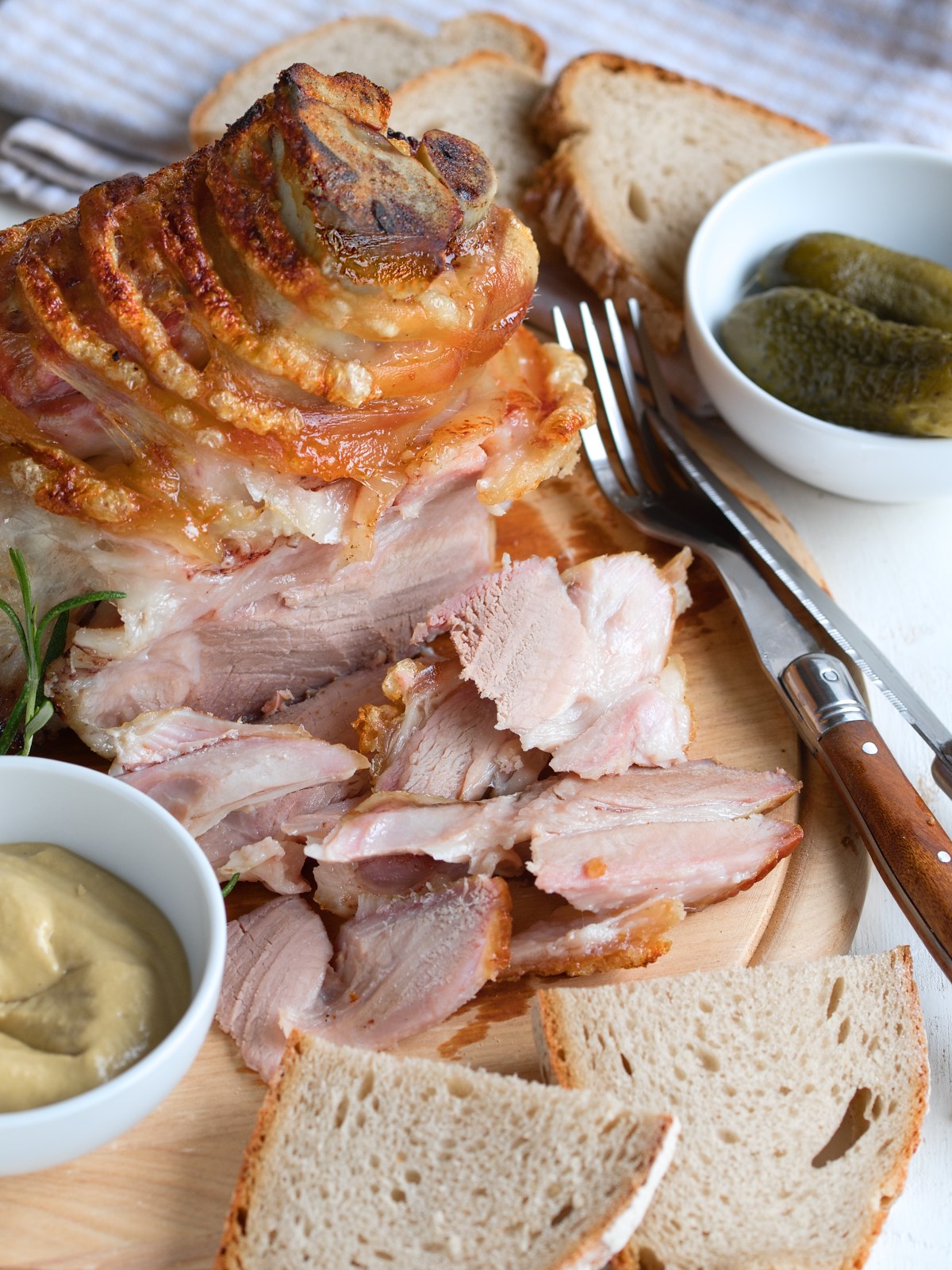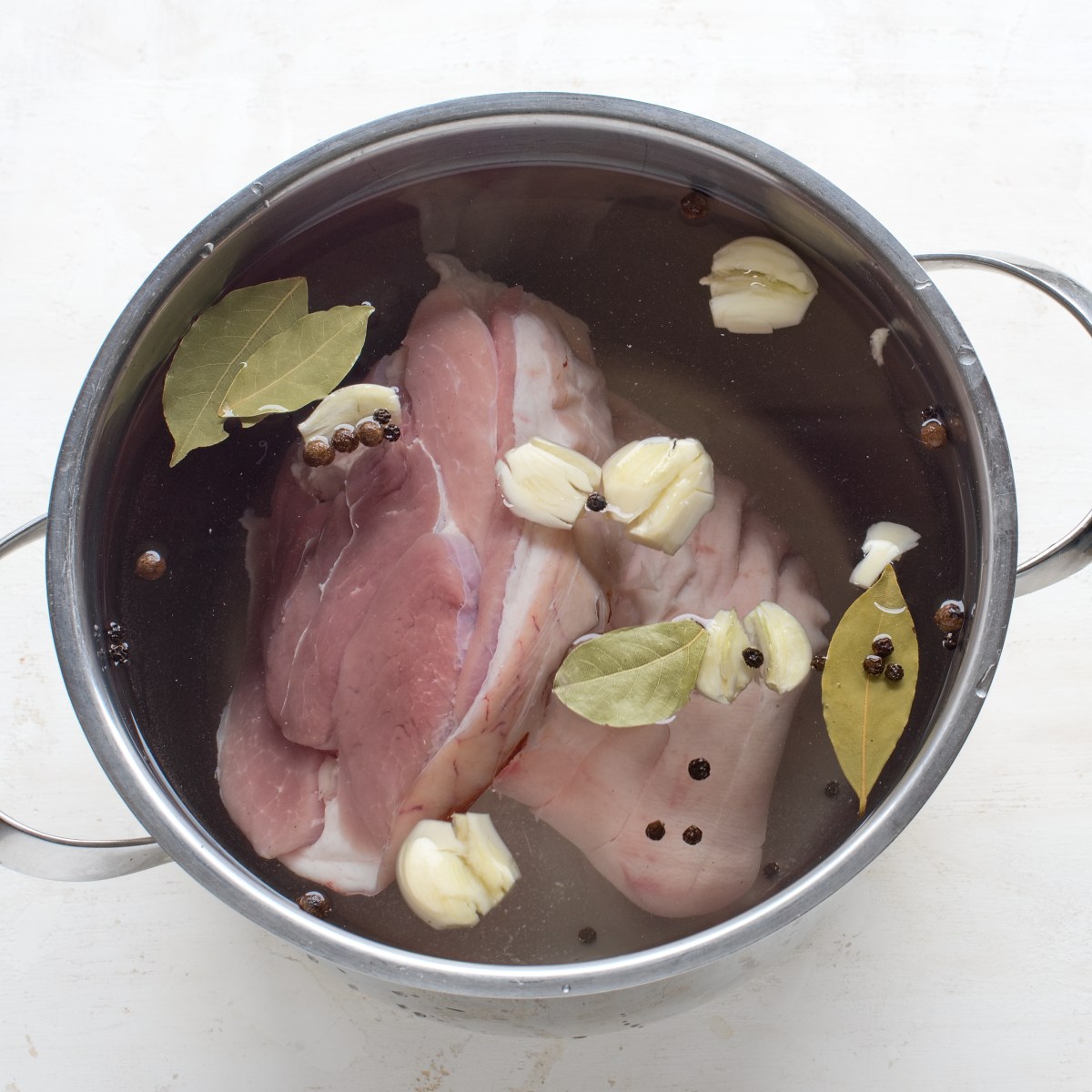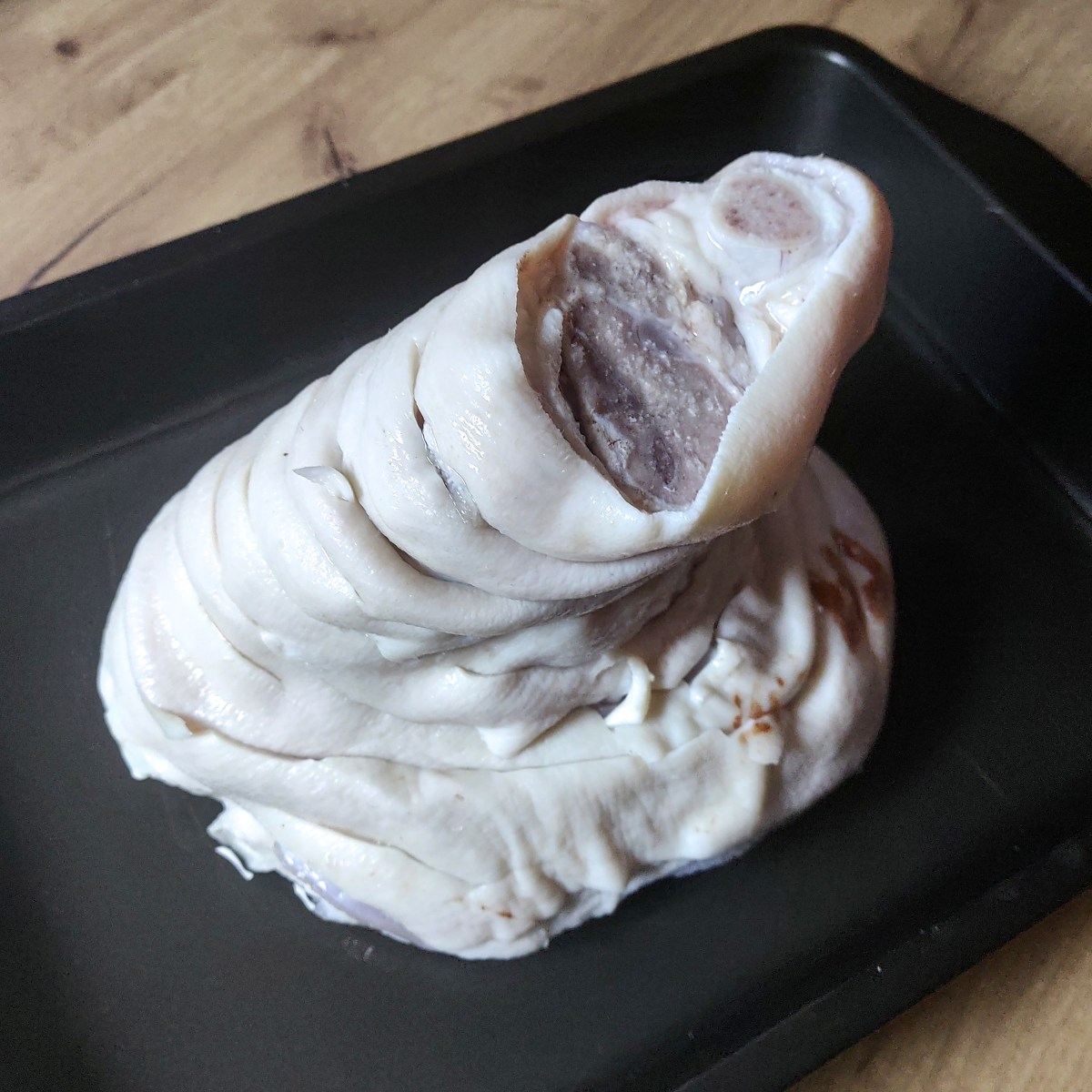Roasted pork knuckle is a classic pub food in Prague, the capital of the Czech Republic. It has shiny and crispy skin on the outside and succulent meat on the inside. In this recipe, I will show you how to make this pork delicacy at home!.
Pork knuckle is a prized cut of meat in certain cuisines, especially German, Austrian, and Central European cooking. But despite its name, pork knuckle doesn’t actually come from a pig’s foot or trotter. So what cut is pork knuckle really and where does it come from on the pig?
In this article, we’ll identify exactly what pork knuckle is, where to find it, how to cook it, and some mouthwatering recipe ideas. Let’s satisfy our curiosity about this delicious and oddly named meat!
What Is Pork Knuckle?
Pork knuckle is the upper part of a pig’s leg specifically the meaty region between the knee joint and the ankle/trotter. It’s the muscle that was attached right above the pig’s foot.
This cut is known by many names including:
- Pig knuckle
- Pork shanks
- Pork hock
- Ham hock (though this can also refer to cured/smoked pork knuckle)
So when people refer to pork knuckle, pig knuckle, shanks, or hocks, they are all talking about the same basic cut – the upper hind leg of the pig.
Why the Confusing Name?
With a name like pork knuckle, it’s easy to assume this meat comes from the actual joint of the pig’s leg But that is not the case.
The name seems to stem from the use of pork knuckle in dishes like pea soup with ham hocks. The term “hock” refers to the whole leg of pork from the bottom sirloin up to the ankle. Over time, this name came to be used specifically for the upper portion.
Other contributing factors may be:
- Resemblance in shape to an actual knuckle or knee joint
- The presence of the aitch (hip) bone in the cut
So while the name is confusing, rest assured you are not eating the pig’s knees or ankles when you enjoy pork knuckle!
Where to Find Pork Knuckle
Pork knuckle can be difficult to source at some regular supermarkets or butcher shops. Here are a few tips for tracking it down:
-
Check at specialty meat shops or old-fashioned butchers. It will likely be tucked away in the cold room rather than displayed up front.
-
Asian grocers often stock pork knuckle as it’s used in Chinese and Korean cuisines.
-
You may need to specifically request rear leg knuckles, as these are the preferred cut.
-
Buying online from quality specialty meat retailers is an option too.
-
Pork knuckle is also sold brined or cured as hams hocks, though this style is not ideal for certain recipes. Opt for a raw, fresh knuckle if possible.
With some persistence, you should be able to get your hands on the real deal pork knuckle to experience its signature flavor and texture.
How to Cook Pork Knuckle
While large and intimidating, pork knuckle couldn’t be easier to cook. The keys are low and slow cooking to let the meat become fall-off-the-bone tender. Here are some easy methods:
-
Oven Roasted – Score the skin, season with salt and pepper, roast uncovered on a bed of vegetables for 3-4 hours at ~325°F.
-
Braised – Brown the knuckle then braise in liquid like broth, beer or wine for 2-3 hours until meat is tender.
-
Slow Cooker – Add knuckle to vegetables in a slow cooker with seasoning and cook on low for 7-8 hours.
-
Pressure Cooked – Pressure cook for 45-60 minutes with spices and vegetables for flavor.
The collagen-rich meat shreds easily once cooked. For extra crispiness, put the knuckle under the broiler after roasting or braising to crisp the skin.
Delicious Pork Knuckle Recipe Ideas
Here are just a few of the mouthwatering ways pork knuckle can be prepared:
-
Schweinshaxe – The German pork knuckle classic, rubbed with spices and roasted for 3-4 hours until tender and juicy.
-
Kassler Rippchen – Brined and smoked pork knuckle, then grilled or pan fried into delicious ribs.
-
Jokbal – A Korean favorite, simmered pork knuckles glazed in a sweet soy sauce marinade.
-
Pork Knuckle and Sauerkraut Stew – Braised pork knuckle and vegetables in a rich tomato and sauerkraut-based broth.
-
Mexican Pork Hock and Bean Soup – Chunks of pressure cooked pork knuckle in a seasoned broth with beans and vegetables.
From European to Asian to South American cuisines, pork knuckle finds a welcome place on menus and tables globally.
Why Pork Knuckle is Prized
Besides having a fun, quirky name, what makes pork knuckle worthy of its place in the meat pantheon?
-
Flavor – The rich, fatty meat takes beautifully to curing, smoking, and seasoning.
-
Texture – Long cooking renders collagen into succulent, shredable meat that falls off the bone.
-
Versatility – It can be the star of rustic stews or elevated restaurant dishes.
-
Value – As a less popular cut, pork knuckle is budget-friendly yet packed with taste.
-
Tradition – Pork knuckle is integral to German, Austrian and Chinese food culture and history.
So don’t be put off by the odd name – embrace this under-appreciated cut and all its finger-licking, melt-in-your-mouth potential. Pork knuckle is definitely a unique treat for the adventurous cook and meat lover.
Final Thoughts
While the name may not fully make sense, pork knuckle has earned a cult following for its signature robust flavor and tender texture. Seek out this leg cut at specialty butchers and markets to experience pork knuckle in all its glory. A long, slow braise or roast coaxes every ounce of flavor out of the meat and connective tissue. Served alongside hearty sides like sauerkraut, dumplings or beans, pork knuckle makes for a mouthwatering, rustic meal that’s surprisingly easy to master. Don’t knock it ’til you’ve tried it – pork knuckle could just become your new favorite cut of meat!

➜ What is good to know
Before I get into the recipe in more depth, let me give you a quick outline of what to expect.
- I put the pig knuckle in a salted brine with spices three days ahead of time.
- then I roast it slowly for 5. 5 hours in the oven at 250°F/120°C.
- Lastly, I briefly raise the temperature to 450°F/230°C to get a skin that is crispy.
Please, dont get discouraged. The recipe is actually very easy, and nothing can go wrong when making it. Time is the most crucial component here!.

➜ Choose the right piece of meat
There are knees on the front and back legs of the pig, but for this recipe, I recommend the back knee because it has more meat.
One hind hock of pork weighs around 3–4 pounds (1. 5-2 kilograms), with most of the weight being bones. One roasted pork knuckle can easily feed two hungry diners.
I buy skin-on pig knuckles from a butcher in my area or a grocery store with a meat section.
Fun fact: Pork knuckle is also known as pork hock, pork shank, or pig knuckle. In Germany, which borders the Czech Republic to the west, pork knuckle is also a popular pub treat. The Germans call it Schweinshaxe.

To make Czech pork knuckle, you will need:
- Skin-on pork knee; from a hind pork leg
- Water
- Czech wild spices: Allspice, black peppercorns, bay leaves
- Fresh cloves of garlic
- Salt
- White sugar
The recipe card below has the exact amount of each ingredient. You can also print it out.
STEP 1: Clean the knuckle under running water. Take a sharp knife and score the skin all around. Continue to cut the skin in the shape of strips about 1/2 inch (1. 2 cm) apart. That way, the brine will soak into the meat better, and after roasting, the skin will be easier to eat.

MY TIP: Put the meat in the freezer for 30 minutes to make the skin easier to cut!
STEP 2: Make a brine. Prepare a narrower and taller pot. Put the meat in it and pour in the water. Note down how much water you need to keep the knee completely submerged.
The measured amount of water is then flavored to form a brine. I used 3. 5 liters of water to make the recipe for one pork knuckle. The pot I used was 25 cm in diameter.
Add salt and sugar to the cold water, and stir well to create a salty solution.
STEP 3: Brine the knuckle: Place the pork knuckle in the pot, flesh side down, bone side up. Pour the brine over the meat so that it is completely submerged. Add the peppercorns, allspice, and bay leaves. Peel the garlic cloves and use a knife to roughly crush them. You don’t have to press them very hard. Add the garlic to the brine as well. Stir briefly.

Three to four days should pass after putting the pot with the brined knuckle in the fridge. Check every day. Turn the meat over so that the brine soaks into all of its parts if some of them aren’t there.
STEP 4: Roast the brined knuckle: Pour a cup of clean, hot water into the baking dish. Remove the knuckle from the brine and place it meat-side down in the dish. Preheat the oven to 250°F/120°C and bake the pig knee for 5½ hours.
Check occasionally and add a little more water if necessary.

Step 5: Make the crust crispy by turning up the heat to 450°F/230°C and baking until the skin is golden brown. Crispy blisters will form on the surface. If your oven has a grill function, turn it on for the last few minutes. Keep an eye on the roast, though, so the top doesn’t burn—it cooks quickly in a hot oven!
The pork knuckle recipe that has gathered millions of views on Youtube!
FAQ
What part is pork knuckle?
What is pork knuckle good for?
Is it pork leg or pork knuckle?
What is the difference between pork shanks and knuckles?
How to cook a pork knuckle?
Poke the skin of the pork knuckle a dozen times with a sharp knife. Rub salt and pepper into the skin. Cut the potato and onion into chunks and put them into a roasting dish. Place the pork knuckle with skin side up on top of the vegetables. Put the roasting dish in the oven and cook at 325F for 4 hours.
What is pork knuckle?
Pork knuckle, also known as pig knuckle, pork shanks, pork hock, or ham hock (though the latter refers to smoked or cured hocks), is a cut of meat from the upper part of a pig’s leg. It is not to be confused with pig’s trotters or feet.
What do roasted pork knuckles look like?
The roasted pork knuckles always look a bit different, depending on how much skin is left on and how it was cut, but it always turns out to be a tender piece of meat nestled under crispy skin. And almost always served with potato dumplings on the side! The pork knuckle is located at the end of the leg, before it becomes the ankle.
Is pork knuckle a German dish?
Yes, pork knuckle, also known as Schweinshaxe in German, is a traditional German dish. It is a popular and iconic dish in German cuisine, particularly in Bavaria. The knuckle is typically roasted or braised until the skin becomes crispy and the meat is tender and flavorful.
